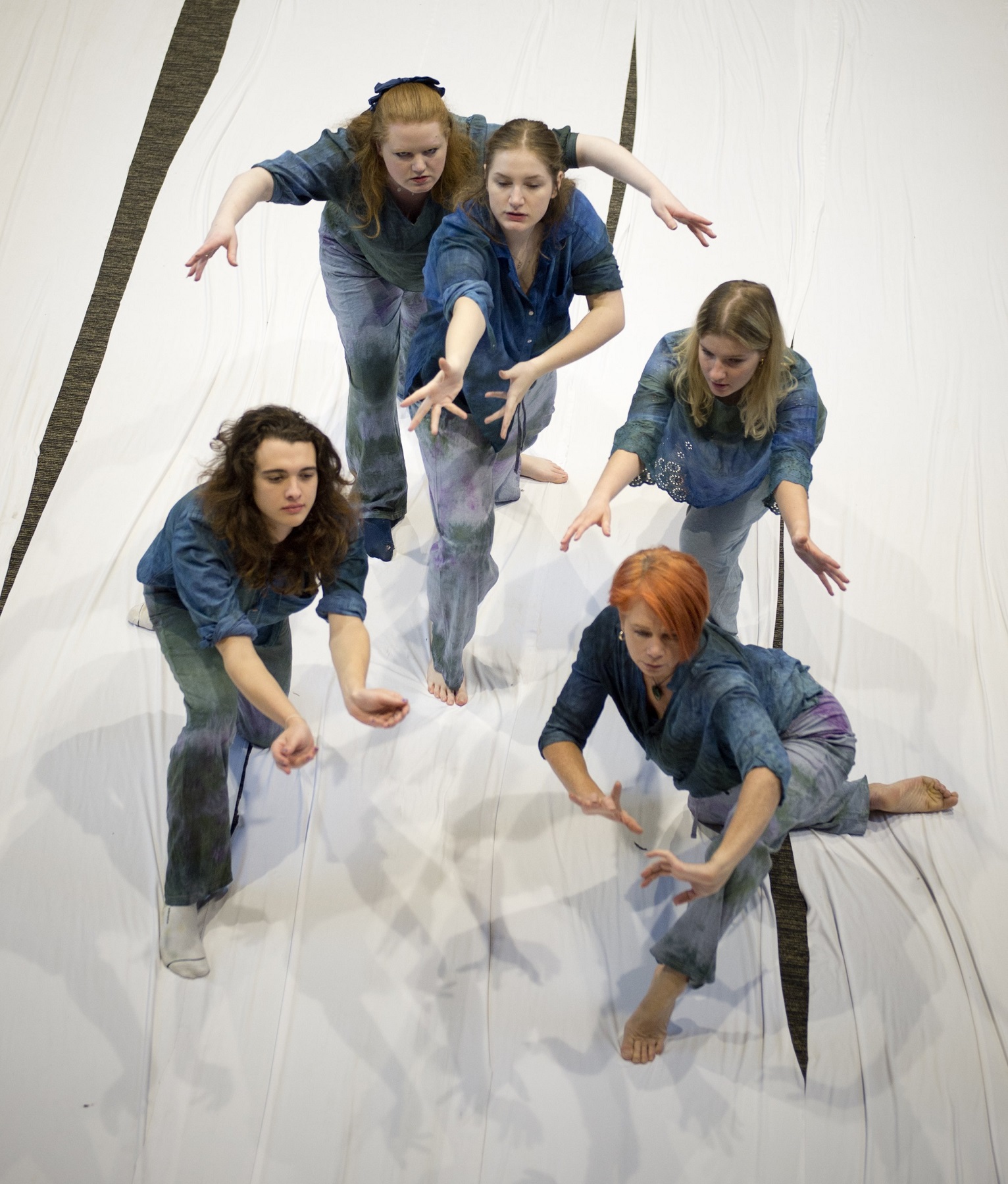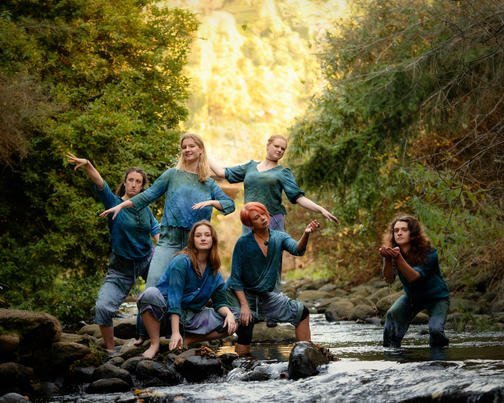
Bringing characters to life without words is the challenge of a new physical theatre ensemble charged with adding a fantastical touch to Shakespeare’s The Tempest.
As fairies and nymphs, Esther Smith, Imogen Duncan, Rochelle Brophy, Oliver McKeown, Stella Wispinski, Zac Henry and Matt Brennan, led by Becky Hodson, are part of a crew of 30 actors, singers, dancers and musicians tasked with bringing the play to life in a multi-disciplinary production directed by Blaise Barham of SBZ Productions.
"It’s a conventional play with so many unconventional elements. It’s a very immersive take on Shakespeare," Hodson says.
"It’s ambitious - it allows everyone’s skills to shine."
Barham is turning Hanover Hall into Prospera, the exiled duke of Milan’s enchanted island where she has been stranded with her daughter for 12 years before using her magical powers to conjure up a fearsome storm so that her enemies are shipwrecked and stranded on the island.
The play will happen all around the audience with performers on the floor, in the gallery and on stage. The audience will be guests of King Alonso returning back to Naples on the ship from Claribel’s marriage in Tunis. They will board the ship and be shipwrecked, becoming part of the journey on the enchanted island.
"We’re very assisted by the environment. They’ve turned the hall into the setting of different places in the play. It becomes the boat and then the island. Because it’s such an atmospheric location I’ve found it really helpful when you don’t have words to bring the truth of the experience alive," Smith says.
As well as the actors performing the classical Shakespeare script, throughout the play the physical theatre ensemble will take on various guises as the spirits of Prospera’s magic, the island and the audience.
"We physicalise the land, the trappings of the characters, the hallucinations they see."
The ensemble essentially has three different roles - to be the spirits, embody the characters’ inner emotions such as temptation or grief and then build different atmospheres.
Hodson sees it as being the bridge from the characters to the audience.
"We interact with the audience. We invite them to come play with us and we really hope people do. We have all these ideas but in rehearsals we don’t have people to do it to yet."


"The physical theatre team in certain scenes work to make that image a stronger one for the audience," Smith says.
Hodson says the tricky thing about Shakespeare is if you do not know much about the story and language it can be hard to grasp the first time.
"We just add another element to visualise the action. Shakespeare is such a beautiful language and we have such talented actors performing it that we need just one more thing to show you all the little elements you may have missed."
Smith agrees: "They physical element makes the language easier to understand, all the subtext. It makes it clear or adds to it even."
For most of the ensemble the concept of physical theatre - performing where physical movement is the primary method of storytelling - is new, although most have a movement or theatre background of some sort from classical ballet to aerial dance.
"You are using movement, solo or ensemble, to communicate a narrative. What is pretty unique to The Tempest is you also have real actors, all these different types of storytelling. We have singers on top of that."
Smith says for her physical theatre brings a character to life without words.
"It has an element of dance in it but it is more than moves, it is an embodiment of a character, a mirror strengthening their action, enhancing a moment."
In the case of Caliban, they play a game with him.
"It is about, where is the give and take? This is a physical group moment and then use physical distance to let Caliban have his space."
It also gives them licence to do more than an actor can.
"We’ve drawn on a lot of real creatures and make-believe creatures to inspire different parts of our movements. Demon dogs was one of our inspirations, sprites or pixies another. Whatever the scene calls for - prima ballerinas, music box and puppetry, Irish dancers."
They are often creating conflict in a scene, Hodson says.
"One of the most fun things of the devising process has been finding these sources of inspiration. Looking at theatrical movements like Japanese-style Butoh, which is a form of physical theatre, which has been so challenging as we haven’t been trained in it. It’ll be a homage to Butoh style.
"We have Spanish influence, we have baroque influence, we have French influence, we have Irish influence. I think that’s what makes it so surreal and magical. I can see all these puzzle pieces coming together."
For the actors among them it is a great challenge.
"The minute you take the words out then you have to consider your body language, your inner thoughts, on a completely different level as you don’t have words to fall back on," Smith says.
Hodson, who is doing her honours degree in theatre studies and first performed The Tempest at 7 years old, has taken part in previous SBZ productions such as the The Bear and learnt aerial silks as part of that.
"It’s so fun - it was the greatest joy. I’ve always had an incline toward physical theatre. It’s my thing."
Smith, a drama teacher, is an actor but grew up learning different styles of dance before moving into theatre.
"I’ve found physical theatre as a way of using my dance training in an actor space. It’s an awesome opportunity to experiment with physical theatre for my students as well."
The group has quickly become an ensemble, understanding each other’s ideas and concepts.
"Now that we’ve got the movements and our general movement patterns organised, it’ll be really building into ensemble - it’s what makes it."
That is a major difference from acting, which is often very focused on just one person.
"It’s an extra thing to do, to feel at one with the characters around you. But with the physical theatre group, it’s just like that - we’re all the same, we are one body. I love collective storytelling."

In this production, the group will be keeping to the ground, so the biggest skills they have been learning are communication, listening and collaboration.
"You have to be able to trust the people around you. If you don’t know, someone else will step up and help," Hodson says.
Physically, they have been working on their strength and grace to learn the routines and develop muscle memory.
"You can see it so clearly when someone has a dancerly grace or flow. It’s such a joy seeing that - when we are all flowing, the ensemble working together."
Smith has found internalisation to be important in her preparation for the role.
"You turn experiences inward and let them flow out physically. Even if you’re not saying anything you are using your body and expression to show the audience those thoughts. Physical theatre forces you to learn those skills as you don’t have text."
Their role in the work will also be emphasised by costumes designed by Sofie Welvaert that allow them to move.
"You are already everything you need. When you are an actor a lot of your character is informed by your costume. We feel really complete as we are and once we have ensemble costumes all the same it will enhance the connection," Hodson says.
They are both very excited about the production and how it will be breaking new ground for many of them. And keeping themselves fit and healthy with yoga and stretching.
"It’s a different kind of pressure to being an actor. As an actor you are very careful with your voice but for us we have to be more primed with our bodies. It’s a don’t-get-a-sprained-foot pressure."
To see:
The Tempest, Hanover Hall, Dunedin, June 13, 8pm; June 14, 1pm and 7.30pm; June 15, 7.30pm; June 16, 2.30pm











